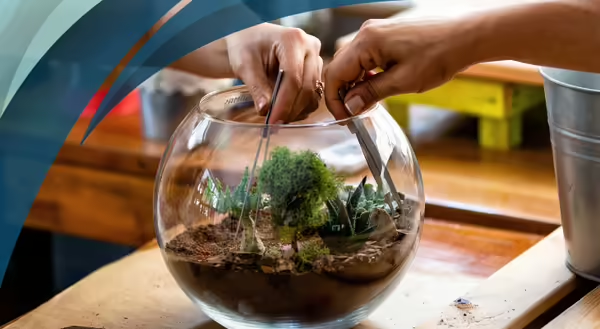
Fall is now in full swing with temperatures reaching down to the 30s at night and Halloween just around the corner. As we prepare our landscapes and gardens for a long winter’s nap, don’t let those seasonal blues get an early start. Why not start a plant project with your family or to give to a loved one at the holidays?
Impossible bottles – or bottles with an object inside that doesn’t seem like it can fit through the bottle’s mouth – have been things of wonder throughout history, with ships or decks of cards being built inside. Bottle terrariums are similar feats of wonder using plants. Terrariums are either tightly closed or open transparent containers with plants inside. Credited for inventing terrariums, Dr. Nathaniel Bagshaw Ward used hermetically sealed glass containers with soil to better observe the change of the chrysalis of sphinx moths.
Creating bottle terrariums
Bottle terrariums are a creative way to use plants and recycle old bottles, and turning them into works of art is fun and easy. When designing a bottle terrarium there are a few questions to think about first. Will it be an open or closed terrarium? What type of container is wanted? What is the theme? What plants – tall or small – will be used? Are there any additional decorations?
Closed terrariums will act like a greenhouse and be a mini ecosystem. Bottle terrariums with caps, corks, or tightly fitting lids will trap the moisture inside where it will cycle. Open containers are more of a display allowing for larger and taller plants.
Any transparent container can be used as a terrarium. Glass and plastic are the two most common mediums. Besides bottles, commonly used items are fishbowls, fish tanks, jugs, jars, or light bulbs.
Choosing the theme
My favorite part is coming up with a concept. Developing a theme based on an event, season, movie, or genre can help to tell a story and make your terrarium unique. Think of a terrarium as a room in your house, were can even switch items out like seasonal décor. This could be especially fun with holidays, like the current spooky season.
Preparing the foundation
To build a terrarium, first start off with a drainage material such as gravel or stones. This allows water to pool without soaking the soil. When using foraged rocks or shells, boil them for five minutes at a rolling boil to sterilize them and prevent disease or insect issues. Allow them to cool before using.
Add activated charcoal to help eliminate chemicals that could harm the plants. Activated charcoal can be found at garden centers. It is added to the terrarium to absorb any unwanted chemicals that would be taken up by the plant and cause adverse effects to the plant. Next, add premoistened potting mix suitable for the chosen plants. The gravel, activated charcoal, and potting mix should make up about a quarter of the container’s volume.
Picking and placing features
Many plant types such as Kalanchoe, Sempervivum, Crassula, Echeveria, and Sedum can be used in terrariums. To add the plants, skewers, pipe cleaners, and long handled tweezers may be needed depending on the size of the container’s opening. When placing plants, don’t let the foliage touch the sides of the container and wipe any debris off plants with a clean paint brush.
Clean any figures, toys, glass pebbles, or ceramic structures with an alcohol or 10 percent bleach solution and allow them to dry. Dried flowers or wood also may add to the story. Supplies can be purchased from dollar stores, craft shops, and local garden centers.
Tending to the terrarium
To care for the new terrarium, place it near a south or western facing window or near supplemental lighting, not in direct light. Most terrarium plants are in the medium light requirement category.
Watering will vary. Closed, tightly sealed containers will only need to be watered every four to six months. Wilting plants and bottles with no condensation are a sign watering is needed. Open containers need to be watered more often, depending on humidity levels in the home. Don’t overwater.
For maintenance, remove any dying leaves, turn the container weekly to keep plants growing normally, and prune or pinch plants that get tall.
Making terrariums is a great activity with family or friends, and they can make unique gifts for the holidays. For more information, watch our “Creating a Bottle Terrarium” webinar.